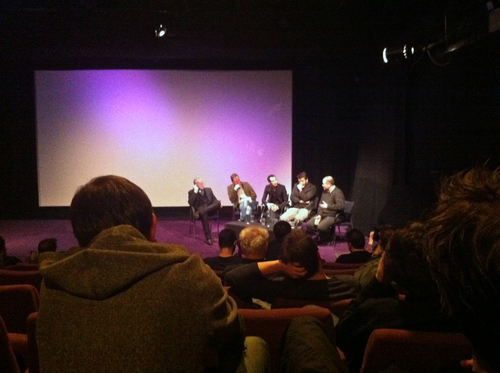I have been to all 3 Converges and it's interesting to see how things have changed. The first one was very much about spreading the word. Many in the audience had yet to experience DSLR video and it was about exploration and spreading the word. The second was more about technique and workflow. In the third, DSLRs are pretty much proven, it was more a celebration of what has been achieved. In fact one of the key issues is whether we were starting to enter a post-DSLR world. There was also a broadening of the scope of convergence looking at the route to market opportunities presented by the web and mobile devices. I attended both days: the festival day and the more technical workshop day.
 Panel Discussion
Panel Discussion
One change is that I took someone with me. My son Alex is hoping to study Film and Television at university. Armed with a 550D, courtesy of his recent 18th birthday, it was the first time he had been to an event like this.
Its a few weeks after the event and my detail memories are starting to fade like they do when you pass 40. Andrew Reid did a great (and considerably more prompt) job on recording the first day's proceeding so I am going to point you there and I going to concentrate what stuck out for me.
Post DSLR?
Nah, not going to happen. Not that the manufacturer’s won’t try and drag us back to the highend and their old margins, but I agree with Philip Bloom, DSLRs are here to stay. The primary reason is cost. There are a lot of disgruntled photographers who are annoyed at having to subsidise these frivolous video modes. We should shake them by the hand because they do! A Sony F3 kit is around £18,000. Now despite the nice tie in between £18,000 and 18 years it was never going to happen - sorry Alex.
Secondly, there is form factor. The may not be optimised for video work but they are comparatively small for the image quality they produce. The also, strangely enough, take very good stills. We may not get everything we want in the DSLR format but I can’t see any camera being produced that does not have a video mode and the manufacturers will always be scrambling for spec supremacy in this hard fought sector.
The 5D MkII is still King
OK, I might be a bit biased here as an owner and it might be just that 5D has just become interchangeable with DSLR as a term. I also know that there are cameras out there which can claim superiority in lots of areas even within the Canon range. However, most of the stuff we saw seemed to be shot on the 5D. This is despite many contributors being cautious about super-shallow depth of field.
The Old Rules Don’t Apply Anymore?
The advent of the DSLR has often been described as a revolution and I would tend to agree with that. For a technology that only arrived just a couple of years ago it has made huge inroads and a high profile. Reading an article about Paul Williams, attendee and monopod winner, in Photo Pro this week it told how Jamie Oliver had suggested the camera be used in his new show. Did that ever happen before?
So the irony for me is that a lot of the properties of operating a 5D are so “old school”. They don’t run for very long, they need separate sound and no-one but the operator gets a decent view of whats going on. That sounds a lot like film to me. If you want to get the very ultimate out of your DSLR then don’t skimp on the craft. Simon Dennis’ footage from a new film called “Dimensions” was some of the best I had ever seen out of a DSLR and it wasn't even graded. In chatting afterwards he told me that he lit it the same way he would for film.
Where the rules are really under the most stress is in the whole production model. DSLRs are an enabling technology. They remove a barrier to entry. I am not a member of the film world but it seems to me that it is a mass of historical barriers to entry - many of which are under stress. There is more demand for content now than there has ever been regardless of what sector or medium you chose. Unfortunately, that demand is also a fairly incoherent mess. We have everything from a Hollywood establishment fighting a desperate 3D fueled, megabuck rear-guard to unmonetarised cloud services like Vimeo. Trying to make sense of this for us was Robin Schmidt of El Skid Blog fame. His explanation of the non-traditional opportunities through the story of his Super Massive Raver project were very thought provoking. There are threats and there are opportunities and to navigate these turbulent waters there are a lot of new things to learn - even for experienced filmmakers.
One of the great things about Converge is getting to chat to everyone in the bar afterwards about the day. It was great to meet people like Andrew Reid of EOSHD and Robin whose blogs I follow. Also Sam Morgan-Moore of Half Inch Rails who had brought some prototypes with him. Also the chance to catch-up with old friends and acquaintances like Philip Bloom and Julian Harding who I met at Phil's London Meet-up